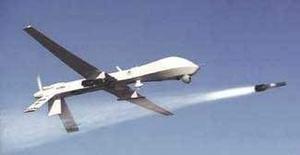DronesAl Qaeda increases efforts to defeat U.S. drones
Drone attacks have been an important part of America’s war against terrorism. These airstrikes have considerably limited the movements and operational freedom of al Qaeda operatives and other militants in Pakistan, Afghanistan, Yemen, and Somalia. Al Qaeda has been exploring strategies and experts to allow it to counter America’s drone campaign.

al-Qaeda cells are trying to find ways to hijack UAVs // Source: commons.wikimedia.org
Drone attacks have been an important part of America’s war against terrorism. The U.S. drone campaign has killed an estimated 3,000 people over the past decade, some of them civilians. These airstrikes have considerably limited the movements and operational freedom of al Qaeda operatives and other militants in Pakistan, Afghanistan, Yemen, and Somalia.
The Washington Post reports that al Qaeda has been exploring strategies and experts to allow it to counter America’s drone campaign. Among the documents released to the Post by Edward Snowden, there are documents which detail al Qaeda’s effort to blunt the effectiveness of the U.S. drone campaign.
The classified report, titled “Threats to Unmanned Aerial Vehicles,” summarizes intelligence assessments issued by U.S. spy agencies since 2006. Intelligence reports conclude that al Qaeda faces “substantial” challenges when fighting the drone campaign, yet drone have weakness which may be exploited by the terrorist organization if it gets its hands on the right technology. The satellite links and remote controls which connect pilots to the unmanned aircrafts can be intercepted or corrupted to compromise drone missions.
The Post notes that the Defense Intelligence Agency (DIA) has reported that al Qaeda was sponsoring researchers to develop jammers to disrupt GPS signals and infrared tags which drone operators rely on to locate targets. The vulnerabilities of drones have been made public by industry experts. Two years ago, the U.S. Air Force Scientific Advisory Board issued an unclassified report warning against the threat of capable adversaries as they invest in effective and inexpensive countermeasures to drone operations. Last year, researchers at the University of Texas at Austin demonstrated to the Department of Homeland Security that it was possible to take control of a small civilian drone by “spoofing” its GPS signal with a ground transmitter and ordering a different navigational course.
Al Qaeda’s history of attracting trained engineers is proving to be a competitive advantage in its campaignt to counter U.S. drone operations. In 2010, the CIA noted in a secret report that al Qaeda’s recruitment initiatives were focused on technicians with expertise in drone and missile technology. That same year, Turkish authorities arrested an al Qaeda member, a 23-year-old mathematics student who was developing plans to shoot down small NATO surveillance drones in Afghanistan. In 2011, the DIA concluded that an “al Qaeda-affiliated research and development cell currently lacks the technical knowledge to successfully integrate and deploy a counterdrone strike system.” It was also noted that if al Qaeda engineers were to “overcome these substantial design challenges, we believe such a system probably would be highly disruptive for U.S. operations in Afghanistan and Pakistan.”
